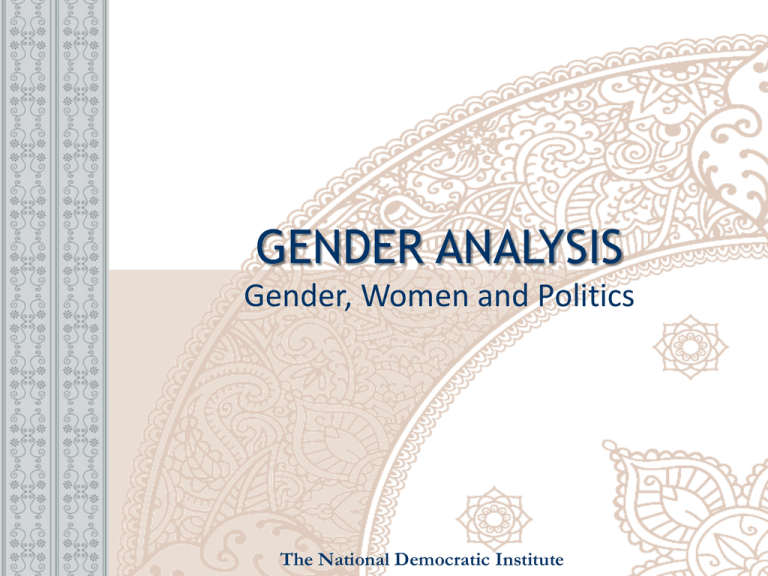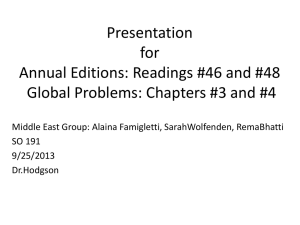
GENDER ANALYSIS
Gender, Women and Politics
The National Democratic Institute
INTRODUCTIONS/
GROUND RULES
• Introductions
• Ground Rules
• Ice Breaker Exercise
GENDER ANALYSIS OBJECTIVES
• To develop a basic understanding of
gender analysis and its benefits
• To become familiar with gender
analysis tools, approaches and data
GENDER ANALYSIS TOPICS
•
•
•
•
•
•
•
What is gender analysis?
Benefits of gender analysis
Key questions
Gender analysis steps
Analysis tools
Data sources
Yemen case study
KEY TERMS
• Gender
• Gender equality
• Other terms?
Photo: Caroline Hubbard, NDI
WHAT IS GENDER ANALYSIS?
• Methodology for collecting and
processing information about gender
• Identify roles, needs, opportunities of
women AND men
• Requires information -- quantitative and
qualitative
WHAT IS GENDER ANALYSIS?
• Explores women’s and men’s
different realities and
expectations
• Considers effects of
interventions
• Ensures benefits and
resources are effectively
and equitably targeted
Image: Billy Alexander, rgbstock.com
GENDER ANALYSIS BENEFITS
• Leads to effective policies and
programs and the efficient use of
resources
• Equal access to resources and
opportunities promotes economic
development
EXAMPLE: IMMUNIZATION
PROJECT IN INDIA
• Immunizations available every Tuesday
• No one came
• What went wrong?
Photo: Julie McCarthy, NPR
GENDER NEUTRAL POLICIES?
• May affect women and men differently
because of differences between them
• May reinforce existing inequalities
WOMEN
≠
HOMOGENOUS
• Gender roles and behaviors vary across:
– Cultures
– Class
– Ethnicity
– Income
– Education
– Age
• Gender attributes change over time
Photo: Amy Hamelin, NDI
GENDER ANALYSIS: WHEN?
• During all phases in program/policy
cycle including:
– Design
– Implementation
– Monitoring and evaluation
• Most effective when initiated during
design phase
GENDER ANALYSIS QUESTIONS
• Who does what within and outside of
the household?
• Who owns/controls/accesses what?
• What are the institutional, economic
and social factors?
Photo: Lindsey Spinks
GENDER ANALYSIS QUESTIONS
• What capabilities, opportunities and
powers do men and women have?
• Did you review sex-disaggregated data?
• Were women and men consulted?
• Have the different needs, interests and
responsibilities been considered?
• What groups are most likely to be
affected and how?
DEVELOPMENT STEPS
Assess current situation/policies and
needs
Collect and analyze sex disaggregated
data
Establish a baseline
Image: World Bank
DEVELOPMENT STEPS
Assess current situation (continued)
Identify/address gaps
Hold consultations
– Experts
– Target groups
Photo: NDI
DEVELOPMENT STEPS
Draft program/policy
Expected impact on women and men
Can negative impacts be overcome?
Implement
Monitor and evaluate
Identify benefits/negative impacts
Solicit feedback and be responsive
EXERCISE: GENDER ANALYSIS
TOOLS
• Gender Role Identification
Use: Program design and planning
Understand who does what
ACTIVITIES
Productive
Reproductive
Community
WOMEN
MEN
GIRLS
BOYS
EXAMPLE: GENDER ROLE
IDENTIFICATION
ACTIVITIES
Productive
Gardening
Livestock Care
Income
Generation
WOMEN
MEN
Household gardens and Wheat crops
maize
Sell extra household
vegetables
Community
Religious
Activities
School
BOYS
Household gardens
and maize
Year-round
Assist
livestock/crop
sales
Sell crops and
livestock
Reproductive
Water-Related
Food
Lead food preparation
Preparation
Childcare
MarketRelated
GIRLS
Collect water daily
Assist food
preparation
Lead childcare
Secondary caregiver
Shops in the
market
Sometimes attends
Always attends
Rarely attends
Always attends
Rarely finish primary
Until secondary
GENDER ANALYSIS TOOLS
• Time Use Analysis
How time is spent based on gender
roles
Highlights women’s unpaid labor
Photo: Alamy
EXAMPLE: GENDER ANALYSIS
TOOLS
Italy
Task
Personal care (sleeping, eating,
grooming)
Employment
Studies
Domestic work (cooking, cleaning,
childcare, shopping, pet care)
Leisure
Travel (to/from work, leisure
activities, shopping, etc.)
Unspecified
Total
Hours (h) Minutes (m)/day
Women
Men
11h12m
1h52m
14m
11h16m
4h15m
11m
5h20m
4h6m
1h35m
5h5m
1h14m
3m
24h
1h35m
3m
24h
GENDER ANALYSIS TOOLS
• Access, Control and Decisions
Use: Program design, implementation
Understand decision-making and
resource controls
ACCESS
Men
CONTROL
Resources
Women
Girls
Boys
Women
Men
Girls
Boys
Land
Yes
Yes
Yes
Yes
No
Yes
No
No
Equipment
Yes
Yes
Yes
Yes
No
Yes
No
No
Labor
Yes
Yes
No
No
Yes
Yes
No
No
Cash
Yes
Yes
No
Sometimes No
Yes
No
No
Education/
Training
No
Yes
No
Sometimes Yes
Yes
No
No
GENDER ANALYSIS DATA
•
•
•
•
•
Regional or country MDG reports
UNDP Human Development reports
State Department Human Rights reports
World Bank reports
Donor and NGO reports
DATA ANALYSIS EXERCISE
• Review data for country
• Develop conclusions about status of
women
• Identify key differences between men
and women
EXAMPLE: EDUCATION POLICY
IN YEMEN
• Enrollment rate for girls to that of boys
– Basic education: 74.8%
– Secondary education: 58.8%
– University: 37.5%
• Good legal framework
• Needs of girls not addressed
EXAMPLE: EDUCATION POLICY
Key challenges:
1) Institutional and structural challenges
2) Lack of access to schools
3) Poverty, social and cultural norms
EXAMPLE: EDUCATION POLICY
Options for increasing women teachers
• Quotas
• Incentives, especially in rural areas
• Financial incentives for schools
• Revisit university degree requirement
Photo: Faisal Darem, Al-Shorfa
EXAMPLE: EDUCATION POLICY
Quotas for women teachers
• Legislation does not provide for quotas
• Policy to replace departing teachers
with women
• Would require close monitoring
GENDER ANALYSIS EXERCISE
Lack of access to schools
• Many children walk over an hour
• Real safety risks for girls
• 9% of girls left because of access issues
GENDER ANALYSIS EXERCISE
• Ensure schools are located to maximize
girls’ attendance
• Expand residential schools
Photo: Luay Basil, World Food Program
GENDER ANALYSIS REVIEW
• Consider roles, needs and
circumstances of women and men
• Leads to better policies and programs
• Conducted throughout program
• Who does what? Who controls what?
• Involve stakeholders in consultations
• Take advantage of existing data











